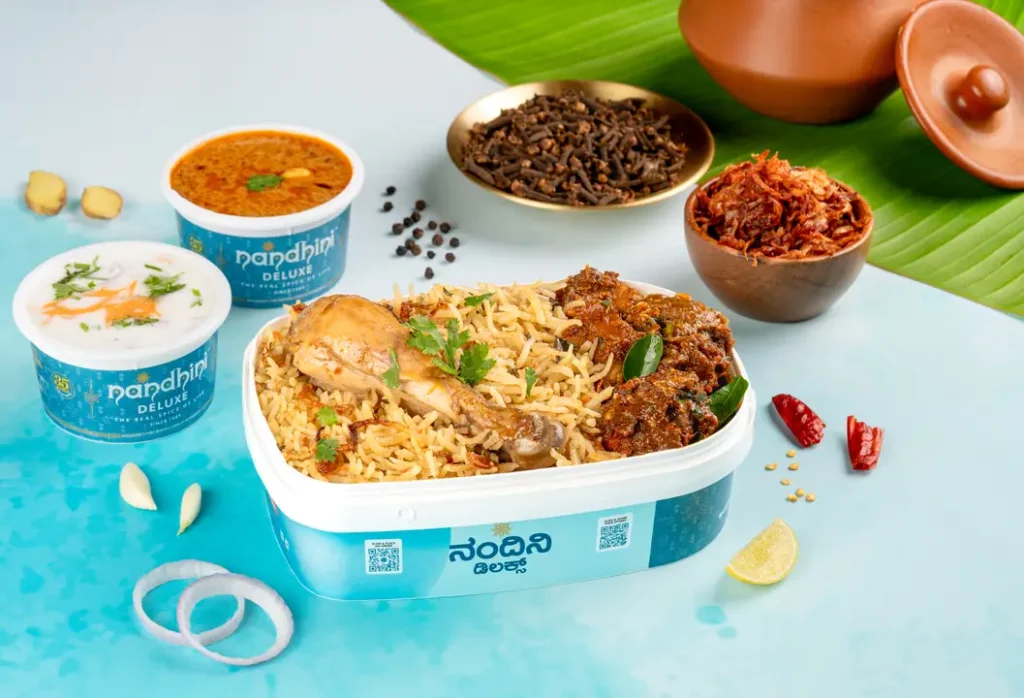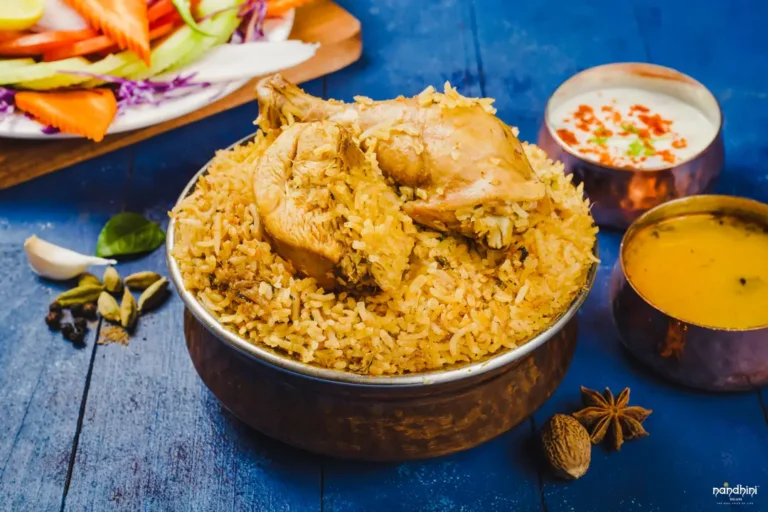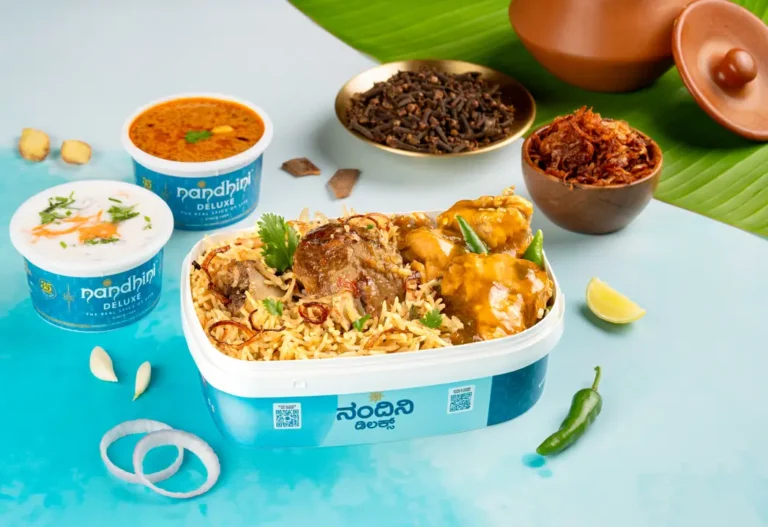Introduction
Steam curls upward from a pot of Nandhini biryani like a quiet signature of Andhra heritage. The fragrance announces something unmistakably bold-smoke, chili, and ghee in perfect synchrony. For Bangalore’s food lovers, this dish is more than a meal; it represents the meeting of two identities: the fiery confidence of Andhra cuisine and the cosmopolitan comfort of the city’s dining culture. Nandhini, a name now woven into the city’s culinary map, has spent decades translating Andhra’s spirited flavors into an experience that fits Bangalore’s rhythm.
The transformation is not about dilution but precision. Where traditional Andhra biryani strikes with unrelenting spice, Nandhini’s kitchens reframe it-balancing heat with aromatic layering, keeping its soul intact while making it universally craveable. Each plate becomes a study in adaptation: the rice long-grained and light, the meat marinated in a measured blend of Guntur chili and yogurt, the aroma distinctly southern yet inviting to all palates.
Understanding this redefinition requires more than tasting the dish. It calls for decoding how Andhra’s culinary DNA evolved, how Nandhini became its most persuasive interpreter in Bangalore, and how a plate of biryani can carry stories of geography, spice routes, and nostalgia.
Key Takeaways
- Andhra cuisine is defined by intensity-heat, tang, and layered spices.
- Nandhini brings Andhra biryani to Bangalore through balance, not compromise.
- The brand’s strength lies in its precise adaptation of spice and aroma to the city’s preferences.
- Exploring Nandhini’s biryani reveals the evolution of Andhra flavors and their integration into Bangalore’s dining culture.
Andhra Cuisine in Context: Core Flavors, Regional Variants, and Tradition
Andhra cuisine occupies a unique position in South India’s food identity. It is simultaneously rustic and intricate, defined by its fearless use of red chilies, tamarind, mustard, and ghee. Every subregion contributes a distinct nuance: the coastal belt favors tangy gravies with tamarind and seafood, Rayalaseema is renowned for its bold spice levels and millet-based meals, while the northern parts lean toward balanced curries and lentil stews. Together, these form a cuisine that celebrates heat, texture, and depth of flavor.
In this tapestry, biryani arrived as both guest and native. Brought by royal kitchens and regional traders, it evolved into a version that is unmistakably Andhra-less perfumed than its Lucknowi cousin, more assertive than its Hyderabadi counterpart. The rice grains remain separate, each coated in masala, and the meat carries the chili’s bite without losing tenderness. This version speaks not of opulence but intensity.
When this tradition migrated to Bangalore, it found both opportunity and challenge. The city’s diners were familiar with Karnataka’s donne biryani and Ambur-style rice dishes, which emphasize aroma and mildness. Andhra biryani entered as a statement dish-bolder, smokier, and spicier. Yet, the balance it demanded led chefs to rethink ratios of chili, acid, and fat. In this negotiation, Nandhini emerged as the most prominent interpreter, managing to keep Andhra’s fiery essence intact while adjusting its edge to the cosmopolitan palate.
Through this process, Andhra cuisine became more than a set of recipes; it became a living dialogue between regions. Each biryani plate in Bangalore tells a story of travel and transformation, carrying the unmistakable red hue of Guntur chilies and the fragrance of adaptation.

Nandhini: The Andhra Pioneer in Bangalore – Brand, Legacy, Philosophy
In the late 1980s, when Bangalore’s restaurant landscape was still modest, Nandhini entered with a clear ambition-to serve authentic Andhra food without compromise. Founded by N. Ananda in 1989, the restaurant began as a family-run establishment that quickly earned recognition for its unapologetic use of spice and traditional preparation methods. Over time, it grew into a citywide brand synonymous with Andhra meals and, most notably, biryani.
Nandhini’s rise was not built on novelty but consistency. Its chefs retained ancestral methods: slow marination, hand-ground masalas, and measured layering of rice and meat in heavy-bottomed vessels. The approach resonated with diners seeking authenticity and became a benchmark for others attempting Andhra cuisine in Bangalore. While many restaurants softened flavors for urban diners, Nandhini maintained its core, letting the quality of ingredients and the discipline of process carry the experience.
The restaurant’s philosophy centers on precision rather than dilution. It measures adaptation not in compromise but in calibration-just enough moderation to let spice meet aroma, allowing first-timers to enjoy intensity without discomfort. Its biryani reflects this thinking. The heat is assertive but not overwhelming; the masala is complex but never muddy; the aroma, layered and persistent, anchors the dish’s identity.
From a single restaurant, Nandhini expanded into a trusted chain across Bangalore, its name etched into the city’s biryani vocabulary. For food lovers, it represents the intersection of authenticity and accessibility-the moment Andhra’s culinary fire found a steady flame in Bangalore. Each plate still carries the same philosophy that began the journey: respect the tradition, understand the diner, and let the biryani speak its own language.
The Biryani Decoded: From Ingredient to Plate
Behind the unmistakable aroma of Nandhini biryani lies a carefully constructed system of balance. Every grain, spice, and cut of meat follows a precise logic. The recipe draws from Andhra tradition, where biryani is not a singular dish but an orchestration of texture, color, and heat. At the foundation are the ingredients-each sourced and selected for purpose. The chilies, predominantly from Guntur, bring a deep red tone and sharp heat. The rice, often a fragrant long-grain variant, provides separation and subtle sweetness. Fresh meat, usually chicken or mutton, is marinated long enough to absorb yogurt, lemon, and hand-ground spices until the flavors fuse seamlessly.
The masala base is what defines Nandhini’s biryani. Unlike many commercial versions that rely on pre-mixed powders, Nandhini kitchens create masalas daily in small batches. The blend balances red chili’s fire with notes of coriander, clove, and cardamom, giving the biryani its characteristic depth without masking the natural taste of meat. During marination, yogurt acts as both tenderizer and flavor carrier, locking the spice into the protein.
Rice preparation is equally strategic. It is parboiled to just the right point-neither soft nor raw-and layered alternately with marinated meat. Each layer receives a measured drizzle of ghee and fried onions to preserve moisture. The sealed vessel undergoes slow dum cooking, where trapped steam circulates to cook the ingredients uniformly. This method allows rice to absorb masala without collapsing, producing separate, aromatic grains infused with flavor.
When the lid finally opens, the aroma is layered rather than overpowering. Ghee floats lightly on the surface, signaling perfect balance between fat and spice. Every component-from the first spoonful of rice to the last bite of meat-reflects a design where nothing is accidental. Nandhini’s biryani isn’t simply cooked; it is engineered to express Andhra’s intensity with Bangalore’s precision.

What Sets Nandhini’s Biryani Apart
A plate of Nandhini biryani engages every sense before the first bite. The aroma rises first-warm ghee, fried onions, and the unmistakable tang of chili-laden masala. The color speaks next: deep russet layers against bright white grains, showing clear distinction between rice and masala, never muddled. The first mouthful reveals why the brand has achieved iconic status. The heat begins gently, builds gradually, and then fades into a smooth finish where the meat’s juiciness balances the spice’s intensity.
Unlike Hyderabadi biryani, which relies heavily on perfumed flavors and saffron sweetness, Nandhini’s version draws strength from grounded spice and savory balance. Its masala is thicker, clinging to the meat rather than pooling in the rice. When compared to Bangalore’s donne biryani, which uses shorter-grain rice and green masala, Nandhini’s stands out for its red chili tone and layered smokiness. It retains the dum technique but amplifies flavor density, offering a texture that feels hearty rather than heavy.
Side dishes complete the sensory journey. A bowl of cool raita offsets the chili’s edge, while the mirchi ka salan introduces tang and bitterness, cleansing the palate between bites. Each accompaniment has purpose-never ornamental. The raita soothes, the salan refreshes, and the pickle sparks contrast. Even the serving method matters. Many branches still use metal handi or heavy ceramic bowls to retain heat and aroma until the last bite.
Consistency across outlets reinforces trust. Whether at the flagship restaurant on St. Marks Road or a suburban branch, the sensory signature remains nearly identical. It’s not uniformity for the sake of repetition but respect for expectation. Each visit delivers the same rhythm of aroma, spice, and satisfaction-a benchmark few biryani brands manage to sustain.
Audience’s Decision Journey & Social Proof
For Bangalore’s biryani lovers, choosing where to eat often begins with a single memory-perhaps a family meal, a festival lunch, or a spontaneous craving. Nandhini has positioned itself within those moments as a dependable choice that delivers authenticity without unpredictability. Reviews and conversations across social platforms reflect a shared sentiment: when craving true Andhra spice, diners turn to Nandhini.
Different audiences arrive with distinct intentions. The Andhra diaspora seeks nostalgia-the familiar burn of Guntur chili and the comfort of rice that feels home-cooked. Young professionals approach it as an adventure, drawn by the restaurant’s reputation for intensity and value. Local Bangaloreans appreciate the balance-spice levels moderated enough for comfort yet strong enough to stand apart from other biryani variants. This layered appeal allows Nandhini to attract both traditionalists and explorers within the same dining room.
Digital reviews echo this divide. Many describe the biryani as “spicy but addictive,” while others highlight the precision of consistency. Social media content often centers on first impressions-the moment the handi opens, the steam billows, and color floods the air. This sensory storytelling fuels word-of-mouth visibility far beyond typical advertising.
The brand’s trust also builds from repetition. Regular diners know what to expect at every branch, from portion size to flavor profile. That predictability becomes a form of reliability in a city known for transient food trends. For many, Nandhini is not just a restaurant but a culinary reference point-the standard against which new Andhra or biryani outlets are measured. In the city’s crowded food map, that reputation is its most persuasive proof of quality.
Evolving the Narrative: Innovations & Future Directions
Nandhini’s success story is not bound by tradition alone. The brand continues to explore how heritage can coexist with innovation. Its chefs regularly test limited-edition biryanis that reinterpret Andhra elements for modern palates-variations with seafood from the coastal belt, seasonal vegetable biryanis using local Karnataka produce, and lighter versions designed for health-conscious diners. Each trial respects the same principle: preserve the flavor identity while adapting to contemporary tastes.
Behind the scenes, sustainability is quietly shaping the next phase. Ingredient sourcing increasingly favors traceable supply chains from Andhra’s farming cooperatives, ensuring both quality and ethical practice. Rice suppliers are vetted for pesticide-free production, and chili procurement emphasizes freshness over stockpiling. The approach reduces waste and strengthens farmer relationships while keeping the biryani’s color and aroma vivid.
Technological adaptation also plays a role. Improved kitchen systems standardize temperature control during dum cooking, guaranteeing consistency across all outlets. Experimentation in packaging now focuses on retaining steam and preventing flavor loss during delivery-critical in a city where online orders dominate.
Looking forward, the brand’s potential lies in storytelling. Visual media, workshops, and behind-the-scenes culinary tours could deepen consumer connection, transforming a plate of biryani into an educational experience. Nandhini’s narrative-spanning three decades of Andhra culinary preservation-positions it as more than a restaurant chain. It represents continuity, evolving with Bangalore’s pace while keeping a steady link to tradition.
Conclusion
Nandhini’s biryani represents more than a beloved dish—it is the embodiment of Andhra cuisine’s strength, carried into Bangalore’s evolving food scene with precision and grace. Every element, from chili selection to dum technique, tells a story of balance between fire and familiarity. The brand’s mastery lies in understanding how to preserve authenticity while adapting to diverse palates, ensuring each meal delivers both nostalgia and novelty.
As Bangalore’s dining culture grows more global, Nandhini remains rooted in regional truth. Its biryani continues to unite diners through a shared appreciation for honest spice and careful craftsmanship. With decades of culinary consistency, the restaurant has turned Andhra’s intensity into an everyday indulgence for the city’s food lovers. For anyone seeking to taste the intersection of tradition, innovation, and identity—Nandhini’s biryani remains the definitive experience.
Frequently Asked Questions
1. What makes Nandhini’s biryani different from other biryani styles in Bangalore?
Nandhini’s biryani stands out for its Andhra-style masala built around Guntur chili, yogurt-based marination, and slow dum cooking. The flavor is bold yet balanced, capturing both heat and aroma without overpowering the palate.
2. Is Nandhini’s biryani extremely spicy?
The spice level is assertive but carefully calibrated. Chefs moderate heat to suit Bangalore’s diverse diners while keeping the authentic Andhra flavor intact. Guests can request milder or stronger versions based on preference.
3. Which Nandhini branch in Bangalore is best for trying the biryani fresh?
Central outlets such as St. Marks Road and Koramangala often serve biryani straight from the dum during peak hours, ensuring the freshest aroma and texture. All branches, however, maintain the same preparation standards.
4. What accompaniments are traditionally served with Nandhini’s biryani?
Each order includes raita, mirchi ka salan, and pickle. These sides create balance—raita cools the palate, salan adds tang, and pickle enhances contrast against the rich rice and meat.
5. Does Nandhini offer vegetarian or limited-edition biryani variants?
Yes. While mutton and chicken remain the signature dishes, Nandhini occasionally features seasonal or vegetarian biryanis made with paneer, mushrooms, or regional vegetables. These follow the same dum process with adapted spice ratios.





